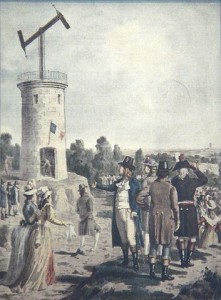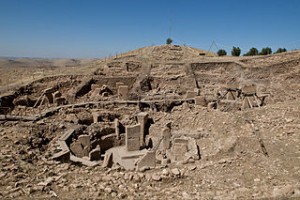The Semaphore Metaphor
Many inventions seem to arrive out of order. That is: considerably ahead of or behind where you’d expect them to show up. One of the best examples of this is the semaphore.

Early Semaphore
The semaphore was a long distance communication system invented in 1792 by the Frenchman Claude Chappe. It takes the form of a series of towers with clear lines of sight between them, with large pivoting arms on top. The arms are moved in a visual code, representing the individual letters, which the next tower in the line then repeats, and so on and so forth.
When it was invented, the semaphore was the fastest method of communication available at the time. There were quite a few limitations, of course: it didn’t work well (or really at all) at night or in bad weather, the towers were expensive to build, several were destroyed by angry mobs, and it required attendants at every tower, which drastically increased operating costs.
You could still send messages faster through the semaphore than by other method, and it saw considerable use for the next 50 years, until the electrical telegraph took its place.
It seems like the semaphore should have been invented much, much earlier. None of the technology was by any means too advanced for, say, the Roman Empire. It’s just swinging arms on a tower, after all, and they had plenty of gears and pulleys and the resources to develop a massive network of them, if they so chose. They had the math necessary to develop codes. There were even a number of Roman experiments in optical telegraphy. So why didn’t they build the semaphore?
The answer is actually pretty simple: telescopes. The Romans lacked the advanced optics necessary to build decent telescopes, which meant that semaphores would’ve been built much, much closer together, to the point where they would no longer be cost effective, even for the mighty Roman Empire.
Technological advancement isn’t conducted in a vacuum. Each new invention requires a network of other advances around it, making new tools, ideas, and techniques available to the inventors. This is not to say there’s a set order in which technology must be invented. Many of our technologies were not an inevitable development but, often, merely choices made for business or cultural reasons, or even out of convenience.
Our technology could have ended up radically different than it did…but it still would have built itself from the ground up.
The Flying Buttress
Everyone's seen flying buttresses. They're those huge pillars on the sides of European cathedrals. Notre Dame (the one in France completed in 1345, not the one with the football team) is among the most famous.

The Flying Buttress
Though they look like they wouldn't be good for much other than making sure that a wall doesn't fall over (sometimes used that way) and making grade school kids laugh, they're the only reason that buildings of that size were even possible in those days.
Flying buttresses actually help support the weight of the ceiling. Before flying buttresses, the walls had to be immensely thick in order to prevent the ceiling's weight from pushing the walls outward.
Flying buttresses form a natural arch with the roof, thereby taking much of the outward force generated by the roof's weight off the walls. This allows the walls to be built much thinner. And it also allows the inclusion of the immense windows in the walls that cathedrals are so famous for.
The construction of the buttresses was a difficult enough task in itself, of course. It first involved the construction of temporary wooden frames, or centering to be hoisted up between the wall and the column. The centering was what kept the arch of stones in the air while the mortar was drying, serving as the arch in the meantime.
Frequently, early cathedrals with flying buttresses were built with much thicker, closer, and more immense buttresses; the backers funding the construction weren't entirely convinced that they would actually work. Some of the buttresses were actually so huge that they blocked out much of the light coming in.
Even cathedrals with much, much thinner buttresses have lasted until today. And a building that lasts for 800 years does tend to speak for itself pretty well.
A Thrill on Potbelly Hill
One of the most interesting construction riddles out there is the archaeological site of Göbekli Tepe (Potbelly Hill) in southeast Turkey. Göbekli Tepe is one of the oldest dig sites on earth: dating back some 14 thousand years, it’s one of the oldest human constructions ever discovered.
It predates almost every single construction technique we know, not to mention the writing, metal tools, the wheel, agriculture, and even animal husbandry. This is a site built when we were still hunter-gatherers.

Göbekli Tepe
The site is largely buried. Only 5% of it is exposed, while the majority is still covered, and only known through geophysical surveys (essentially, underground sonar, though it’s more complicated than that). The site is covered with a tell, which is essentially a flat topped hill composed of disintegrated mud bricks and other building materials; the building site steadily gained in height as new constructions were built over old ones.
The site contains circles of enormous, T-shaped stone pillars fitted into sockets that are carved into bedrock. Most archaeologists believe the site to be a religious one, a burial site, or both.
One of the major conundrums regarding Göbekli Tepe is one of construction. How did a small, scattered population build a site this enormous and complicated? They didn’t have animals to haul the weights, or wheels. It seems likely that primitive versions of the techniques used to construct the Egyptian pyramids and Sumerian ziggurats were used, but it’s extremely difficult to say, since both were constructed closer to the present day than to the construction of Göbekli Tepe. It’s that old.
This has, of course, resulted in the usual ancient-aliens conspiracists coming out of the woodwork to plant their flag on more “evidence.” In actuality, it probably has more to do with the vastly different climate there at that time: it was a lush garden paradise, filled to the brim with game, fruit, nuts, and wild grains, allowing the population to concentrate their population more than other hunter gatherer sites and maintain a larger workforce.
But their specific construction techniques are still a subject of major interest to me, since this is very possibly the oldest archaeological site in existence.
_____
Photo by Teomancimit (Own work) [CC BY-SA 3.0], via Wikimedia Commons
Marvels of Technology…In Your Kitchen
The history of technology we usually teach kids is a flashy one. They hear about atomic bombs, rocket ships, computers. If it’s big, shiny, explodes, is immensely expensive and difficult to create, we teach them about it. Occasionally, we might mention a really important, yet more boring one, like nitrogen fertilizers. But generally? It’s shiny objects all the way down.
Modern nitrogen fertilizers, are, in my book, the most important invention of the 20th century. Forget computers, forget atom bombs: nitrogen fertilizers are what allow us to maintain our global population levels—and they might get a few sentences in your average grade school history book.
When you look at even less-flashy inventions, they get less and less in the way of attention paid to them. In fact, I can almost guarantee that you never think about one of the categories of devices you use most often. Kitchenware.

The Modern Kitchen
Seriously. Go in your kitchen right now, and pick up…let’s say, a rubber spatula. We’ve had rubber for much, much longer than we’ve had rubber spatulas, so why did we invent them? Well, you probably have a non-stick pan, right? Try scraping it out with a metal spatula, and you’re going to scrape off the non-stick coating. (Which, apparently, is really bad for your health.)
Or take a look at cast iron pans. They’ve got a bit of a reputation for being a little on the tough side to clean, right? Well, they used to be considerably easier to clean, but as they drifted a bit more out of popular use (though never went completely absent), a final step of the production process was dropped. They used to be sand casted, then given a strong polish, but this polishing step was dropped to save on costs, so antique cast iron is actually considerably more non-stick.
Every single pot, pan, knife, item of silverware, or bizarre back-of-the-drawer gizmo in your kitchen has an extensive history all its own. And even a cultural context: five centuries ago, a muffin pan would have been pretty much useless scrap, thanks to the lack of common closed range stoves. These are tools that you use constantly and are personally relevant every day. Atom bombs? They can, really, only be personally relevant once.
__________





